Application of Particle Image Velocimetry: High-lift flows
During take-off and landing of civil aircrafts complex multi-element wings shall provide high lift forces, while drag forces shall be reduced to a minimum and separation of the flow needs to be avoided at high angles of attack. Such high-lift configurations consist of three elements at minimum: slat, main wing and flap. The flows over real aircraft wings are partly unsteady or turbulent and very complex. In an experimental study within the EC funded frame work EUROPIV 2 the goal was to investigate the flow over a two-dimensional, slat/wing/flap model in a high-lift configuration. For this, a system for acquiring PIV data from multiple cameras simultaneously was devised and installed underneath the low speed wind tunnel at AIRBUS Bremen. The PIV experiments were performed at the mid-span of the model, for incidences of 12°, 17.5°, and 19°. Nearly 5000 PIV images were obtained, the images capturing the flow fields from the slat wake, slat/wing-gap, flow mixing over the main wing, wing/flap-gap and wing wake. The analysis of the results shows that PIV in industrial-type wind tunnel tests can provide high-quality data revealing the unsteady nature of the flow around high-lift configurations, the mixing that occurs across wakes, plus intermittent flow separation over the flap. Time averaged flow fields at the slat and leading edge position for 12° angle of attack are shown in Fig. 1. The data-set was used for validation of and direct comparisons with hybrid URANS/DES simulations at ONERA, France.
In the EC funded frame work EUROLIFT 2 the flow around a modern 3-D high-lift multi-element wing with nacelle deployed was the topic of experimental investigation in the Bremen Low Speed Wind Tunnel (BLSWT) of AIRBUS. Of specific interest was the influence of the nacelle and pylon-wing junction on flow separation above the wing for high angles of attack. Several measurement techniques have been used in order to understand the flow physics of the separation suppressing effect of a strake vortex generator attached to the nacelle. Besides hot-film- and infrared techniques a traversable Stereo PIV system has been applied for this experiment which enables capturing the trajectory of the wake vortex of the strake in planes perpendicular to the wing surface and the mean flow direction over the suction side of the wing at five different positions and for three different angles of attack without re-adjustment of the PIV system (Fig. 2).
For comparison these five planes were also measured at the same positions and angles at a configuration without strake deployed (see comparison in Fig. 3). In total more than 10,000 instantaneous 3-component velocity vector fields were determined. The analysis shows that the strake vortex enables the suppression of the flow separation (blue regions in Fig. 3 at clean configuration) due to momentum exchange mechanism organized by wall normal fluid deflection along the vortex trajectory.



